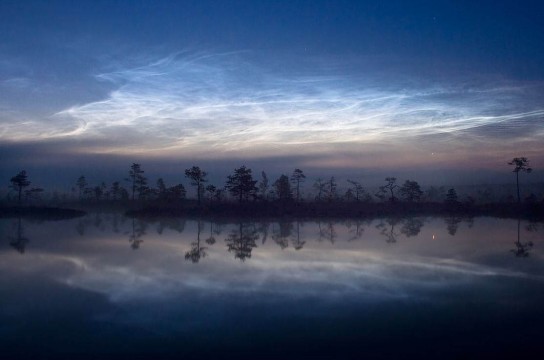
Clear nights are precious, so what self-respecting skywatcher would waste one chasing clouds? Unless they're noctilucent clouds, that is. These electric blue billows at the boundary between Earth and space incite the imagination and inspire us to keep watch at dusk for their arrival.
Noctilucent (night-shining) clouds return every summer between about 45° and 60° latitude, from May through August in the Northern Hemisphere or November through February in the Southern Hemisphere. Infrequent appearances and a habit for hugging the horizon make spotting them a quest akin to finding the Holy Grail.
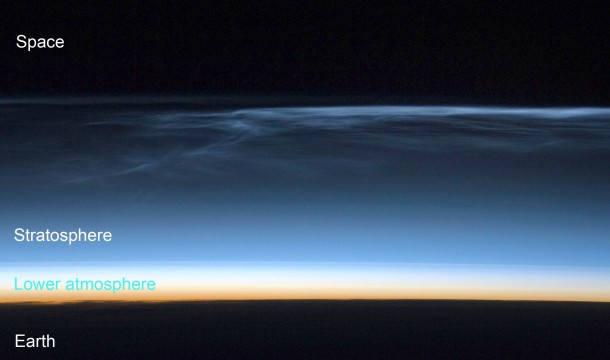
These oddballs of the cloud world are unbelievably high, floating 47 to 53 miles (76 to 85 km) overhead in a layer of Earth’s atmosphere called the mesosphere. Typical high clouds, such as the feathery cirrus we see on a summer’s day, crystallize 4 to 8 miles high, about the same altitude as a transcontinental jet flight.
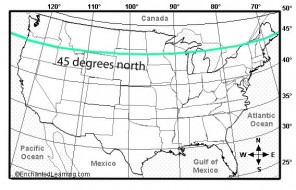
Both are composed of ice crystals, but they grow in different ways. Dust from windstorms and salt from ocean spray are some of the materials that supply condensation nuclei for water droplets and ice crystals in the lower clouds. Noctilucent clouds (NLCs) rely on dust left by flaring meteors — interplanetary soot, as it were. Particulates from volcanic eruptions may also play a role.
"We've detected bits of 'meteor smoke' embedded in noctilucent clouds," reports James Russell of Hampton University, principal investigator of NASA's AIM mission to study the phenomenon. "This discovery supports the theory that meteor dust is the nucleating agent around which NLCs form."
As Earth travels around the sun, it sweeps up some 40,000 tons of interplanetary dust a year, plenty enough to get the job done. As for the water vapor, some may find its way to the mesosphere from summer storms, but methane gas released from both human activities and nature provides a key source. Methane rises high into the stratosphere where it reacts with hydroxyl radicals (-OH) derived from ozone to create the water vapor that freezes onto meteor smoke.
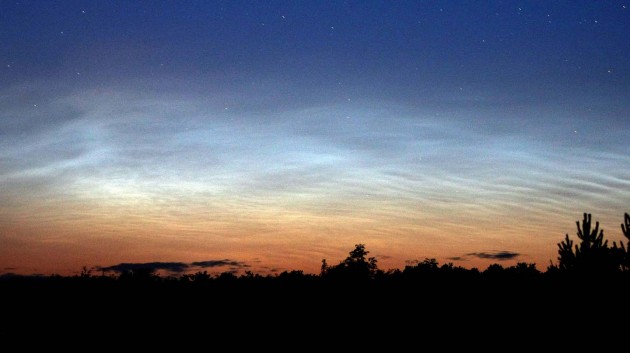
Indeed, it's thought that an increase in the extent and frequency of noctilucent clouds in recent years may be yet another bellwether of global warming. Methane released from intensive agriculture, as well as a drop in mesospheric temperatures caused by a build-up of greenhouse gases such as carbon dioxide, may be behind the "cloud-creep." Once restricted to the boreal north, they've now been spotted as far south as Italy and Utah.
Noctilucent clouds are only visible in deep twilight, from about 75 minutes to 2½ hours after sunset or before sunrise. At latitude 46° north, I live at their fringe of visibility and catch a display about once a summer.
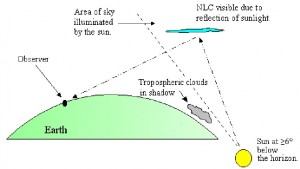
Because of their great height, NLCs reflect light long after sunset, when other clouds have faded to gray. Their color is imparted by the ozone layer, which absorbs the yellows and oranges of reflected sunlight, tinting the clouds a striking silvery-blue.
While they have been seen near the zenith from the higher end of their latitude range, in the northern U.S. they rarely extend above 10° altitude.
In June and early July, displays reach about as high as the bright star Capella in Auriga (6°-8° altitude) for locations in the northern U.S. That means that your cloud-spotting site needs a prime view to the north. Bring binoculars to help you better appreciate noctilucent clouds' supple shapes.
NLCs linger from dusk through early nightfall across the north and northwestern sky and then return around the first light of dawn in the northeast. Not only are they beautiful to look at, but you can contribute to science by noting their form and appearance and reporting your observations to the Noctilucent Cloud Observing Network (NLCNET).
 7
7









Comments
David
June 19, 2014 at 11:15 am
Interesting article. But instead of citing a narrow band of the northern USA, why not point out that almost all of populated Canada and much of Alaska are well within the specified limits for viewing noctilucent clouds? When I lived in Saskatoon, Saskatchewan and Edmonton, Alberta, these beautiful clouds were a common sight in the early weeks of summer. I'm sure they still are. Indeed, I wrote about one such observation in the April 1965 issue of Sky & Telescope.
You must be logged in to post a comment.
Peter Wilson
June 20, 2014 at 2:48 pm
A couple from Saskatoon, Saskatchewan took their January, 2012, vacation in Australia. After getting over the jet-lag, they asked the hotel to direct them to a non-touristy, locals-pub. A local couple, who were regulars there, immediately noticed the foreigners, and the wife insisted that her husband strike up a conversation with them. “How?” he asked. “Just ask were they’re from, and if it’s somewhere interesting, invite them to our table.” So the man ambled over to their table and said, “G-day mates! Where’re you from?” “Saskatoon, Saskatchewan,” the Canadians answered. The man nodded, then strode back to his table. “Well…where are they from?” his wife asked him. “I don’t know…they don’t speak English.”
You must be logged in to post a comment.
GH Martin
June 20, 2014 at 5:08 pm
Peter, that may be totally off-topic, but it sure is funny!
You must be logged in to post a comment.
Peter Wilson
June 25, 2014 at 3:30 pm
The opportunities to tell that joke are so few and far between, couldn't resist. Hope I'm forgiven...
You must be logged in to post a comment.
David
June 21, 2014 at 12:27 am
I believe the same circumstances occurred when a couple from Walla Walla Washington arrived, followed by a couple from Kalamazoo, Michigan and a third from Wollongong, Australia. Lots of funny names out there, many from aboriginal languages.
Now, can we get back to noctilucent clouds, please!
DAR
You must be logged in to post a comment.
Kevin
June 21, 2014 at 12:31 pm
It would be cool to see some noctilucents some day, but I live in Colorado which is too far south. However, what I do get to see with some regularity are "nacreous" clouds which, as the name suggests, have a Mother of Pearl appearance. They are formed when sunlight hits tiny ice crystals hovering up around 80,000 ft or so and are most commonly seen in winter. I have some great pics of them but I used my 35mm using 100 speed film (remember that stuff?) so I can't upload them and scanning would lose too much detail.
You must be logged in to post a comment.
Jim-Baughman
June 23, 2014 at 12:14 pm
I saw a beautiful noctilucent cloud one evening here in West Hollywood CA, and pointed it out to a friend, and soon we had a decent crowd of people that had gathered on Santa Monica Blvd to ooh and aah over it. It wasn't until later that I discovered that we were seeing the vapor trail of a rocket launch from Vandenburg AFB, some ways to the northeast of us on the Pacific coast. Still, it was quite a beautiful sight.
(Interesting that the "spell-checker" in this comment-box does not recognize "noctilucent" as a word...)
You must be logged in to post a comment.
You must be logged in to post a comment.